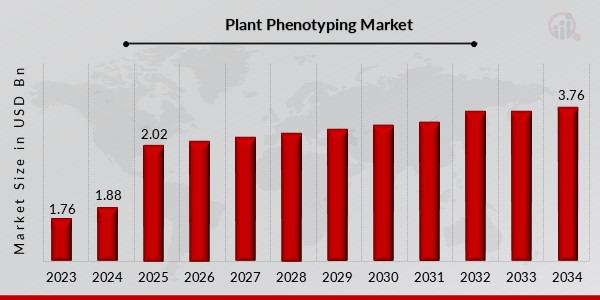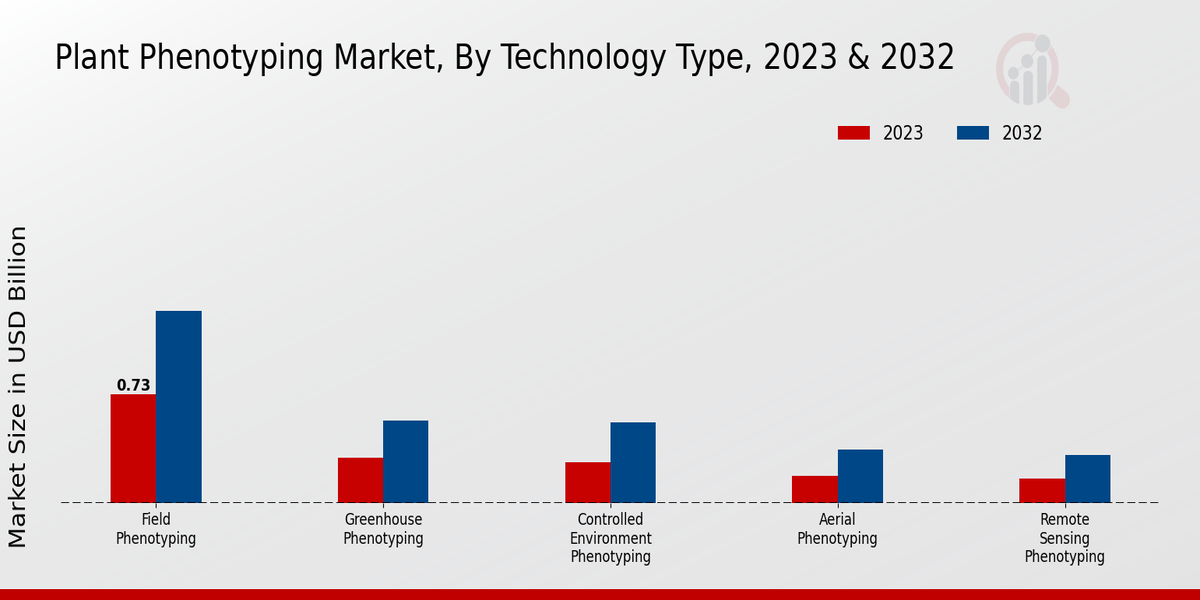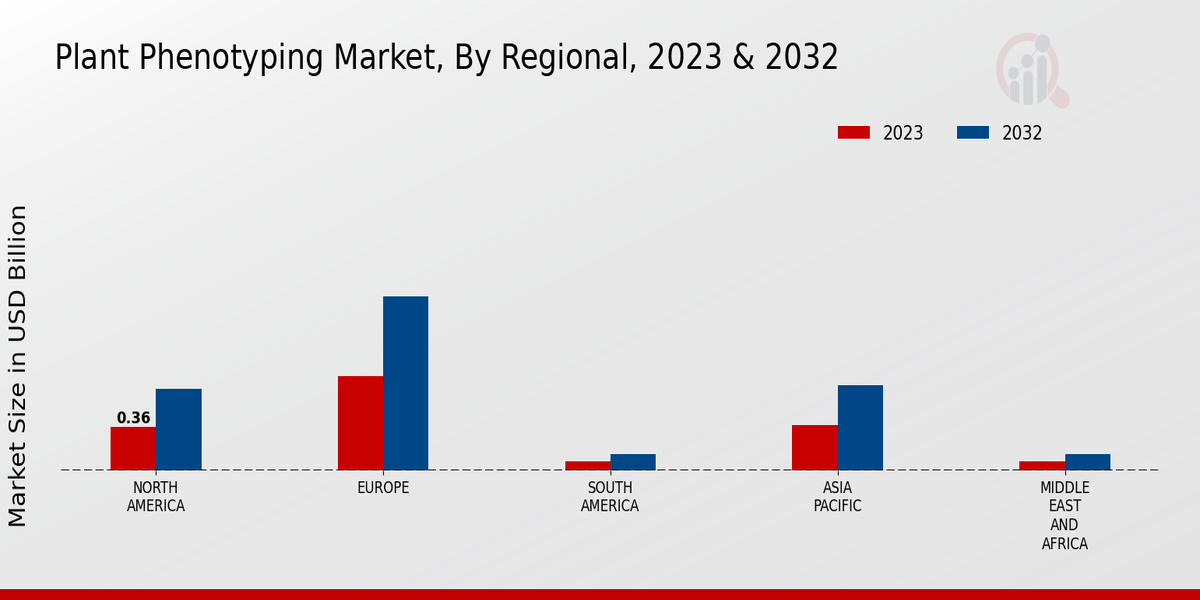Global Plant Phenotyping Market Overview
Plant Phenotyping Market Size was estimated at 1.88 (USD Billion) in 2024. The Plant Phenotyping Market Industry is expected to grow from 2.02 (USD Billion) in 2025 to 3.76 (USD Billion) by 2034. The Plant Phenotyping Market CAGR (growth rate) is expected to be around 7.2% during the forecast period (2025 - 2034).

Source: Primary Research, Secondary Research, MRFR Database and Analyst Review
Key Plant Phenotyping Market Trends Highlighted
The Plant Phenotyping Market is experiencing dynamic growth, driven by technological advancements and increasing demand for high-throughput phenotyping platforms. The adoption of machine learning and artificial intelligence (AI) is enabling the development of automated and efficient phenotyping systems, facilitating seamless data collection and analysis. Moreover, the integration of sensor technologies, such as hyperspectral imaging and LIDAR, into phenotyping platforms enhances data accuracy and precision.Key market drivers include the need for improved crop yield and stress tolerance, regulatory compliance, and the development of drought-resistant crops. Governments and research institutes are investing heavily in plant phenotyping infrastructure to address global food security concerns, further fueling market growth.Opportunities abound for vendors to develop specialized phenotyping solutions tailored to specific crop types and breeding programs. Collaboration between technology providers and plant breeders is vital to leverage comprehensive phenotyping data for trait identification and genetic improvement. The rising demand for phenomics services is also creating opportunities for service providers, while the integration of IoT and cloud-based solutions offers potential for remote monitoring and data sharing.
Plant Phenotyping Market Drivers
Rising Demand for High-Throughput Phenotyping Technologies
The increasing demand for high-throughput phenotyping technologies is a major driver of the Plant Phenotyping Market Industry. These technologies enable researchers to collect and analyze large amounts of data on plant traits, which can be used to improve crop yields and develop new varieties of plants. High-throughput phenotyping technologies are becoming increasingly affordable and accessible, which is making them more attractive to researchers and plant breeders. Some of the key factors driving the demand for high-throughput phenotyping technologies include The need to increase crop yields to meet the growing global population.The a need to develop new varieties of plants that are resistant to pests and diseases. The need to improve the nutritional value of crops. High-throughput phenotyping technologies are helping researchers address these challenges by providing them with the data they need to develop new and improved varieties of plants. As a result, the demand for these technologies is expected to continue to grow in the coming years.
Growing Adoption of Precision Agriculture
The growing adoption of precision agriculture is another major driver of the Plant Phenotyping Market Industry. Precision agriculture is a farming management concept that uses information technology to ensure that crops and soil receive exactly what they need for optimal health and productivity. Plant phenotyping technologies are an essential component of precision agriculture, as they provide the data that farmers need to make informed decisions about how to manage their crops. Some of the key factors driving the adoption of precision agriculture include The need to increase crop yields.The need to reduce the environmental impact of agriculture. The need to improve the profitability of farming. Plant phenotyping technologies are helping farmers address these challenges by providing them with the data they need to make informed decisions about how to manage their crops. As a result, the adoption of precision agriculture is expected to continue to grow in the coming years, which will drive the demand for plant phenotyping technologies.
Increasing Investment in Plant Phenomics Research
The third major driver of changes in the Plant Phenotyping Market Industry is increasing investment in plant phenomics research. Plant phenomics is the study of plant phenotypes, which are the observable characteristics or traits of plants. Plant phenomics research enables researchers to understand how plants respond to different environmental conditions and how they can improve plants for agricultural purposes. These are some of the major factors driving the investment in plant phenomics research: The need to develop new types of plants that are resistant to pests and diseases.The a need to improve the quality of the crops we eat. The a need to develop new ways to produce food for the growing number of people in the world. Phenomics research in plants allows researchers to tackle these challenges by providing them with the information they need to understand how plants grow and develop. As a result, investment in plant phenomics research is expected to increase in the next few years, and this will drive demand for phenotyping technology.
Plant Phenotyping Market Segment Insights
Plant Phenotyping Market Technology Type Insights
The Plant Phenotyping Market is segmented by Technology Type into Field Phenotyping, Greenhouse Phenotyping, Controlled Environment Phenotyping, Aerial Phenotyping, and Remote Sensing Phenotyping. Field Phenotyping is the leading technology type in the plant phenotyping market which is due to the fact that field phenotyping is conducted in natural conditions of the field and researchers are able to study the plant’s response to environmental factors. Sensors, imaging tools and data analyzing tools are used to monitor such plant traits as plant height, leaf area, yield, etc.Greenhouse Phenotyping is the second-largest segment and it is employed in the study of the plant’s response to a controlled environment. Sensors, cameras, and software tools are used for monitoring growth rate, water use, nutrient uptake, etc., on plant traits. Controlled phenotyping is a rapidly growing type of technology that is driven by the demand for high-throughput and accurate phenotyping. Such phenotyping takes place at special facilities with a controlled environment. Special sensor systems are used to monitor root development, photosynthetic activity efficiency, stress response, etc.On plant traits. Aerial Phenotyping is an emerging type of technology due to the wider application of drones on the one hand and restrictions related to the usage thereof. Drones equipped with sensors and cameras are used to monitor such plant traits as canopy, biomass yield, etc. Remote phenotyping is another emerging type of technology based on images from satellites and other remote digital technologies. These are used to monitor plant traits in the form of vegetation indices, area of leaves, crop health, etc.

Source: Primary Research, Secondary Research, MRFR Database and Analyst Review
Plant Phenotyping Market Application Insights
The Plant Phenotyping Market is segmented by Application into Crop Improvement, Disease Diagnostics, Trait Discovery, Stress Tolerance Assessment, and Yield Prediction. Crop Improvement accounted for the largest share in 2023 and is expected to dominate the market during the forecast period. Plant phenotyping is essential for crop improvement applications as it allows the identification and selection of desirable traits suitable for breeding programs. As such, crop improvement phenotyping ensures that crop yields, quality, and resiliency to environmental stresses are optimized.Disease Diagnostics also represents a sizable application segment, as there is a growing demand for disease detection methods that are both accurate and rapid. The employment of phenotyping to characterize disease symptoms facilitates the early diagnosis of diseases and, in turn, ensures crops are treated in a timely manner, thereby minimizing losses and maintaining food security. Trait Discovery is characterized by the identification and characterization of new plant traits and capabilities, such as nutritional value, resistance to pests, and others.Phenotyping enables the discovery of new traits which can be leveraged to create improved plant varieties. Stress Tolerance Assessment phenotyping is becoming more popular as the frequency and severity of environmental stresses such as drought, heat, and salinity continue to rise. Stress tolerance assessment phenotyping is employed to evaluate the response of plants to an array of these stresses since some genotypes are capable of tolerating such conditions more effectively. Phenotyping data are used to estimate the yield in Yield Prediction applications, which is employed as part of the improved modeling of yield effects on the growth of plants.
Plant Phenotyping Market Crop Type Insights
The Crop Type segment is a crucial aspect of the Plant Phenotyping Market, encompassing various types of crops cultivated worldwide. Key crop types include cereals, legumes, oilseeds, fruits, and vegetables. Each crop type presents unique challenges and opportunities for plant phenotyping, driving the demand for specialized solutions. Cereals, including wheat, rice, and corn, hold a significant share of the Plant Phenotyping Market revenue. The increasing demand for staple food crops and the need to enhance yield and quality have fueled the adoption of phenotyping technologies in this segment.Legumes, such as soybeans, lentils, and peas, are also gaining prominence due to their nutritional value and role in sustainable agriculture. Oilseeds, including rapeseed, sunflower, and soybean, represent a growing segment in the Plant Phenotyping Market. The rising demand for vegetable oils and biofuels has stimulated innovation in phenotyping methods to improve oil content and yield. Fruits and vegetables are essential components of a healthy diet, and their phenotyping is crucial for ensuring optimal nutritional value and yield. The Plant Phenotyping Market is expected to witness substantial growth in the coming years, driven by the increasing need for food security, the development of advanced technologies, and the growing awareness of sustainable agriculture practices.
Plant Phenotyping Market End User Insights
The end user segment of the Plant Phenotyping Market is broadly classified into seed companies, agricultural research institutes, universities, government organizations, and agrochemical companies. Seed companies accounted for the largest share of the market in 2023 and are expected to continue to dominate the market throughout the forecast period. This is due to the increasing demand for high-quality seeds, as well as the need to improve crop yields. Agricultural research institutes are another major end-user of plant phenotyping technologies, as they use these technologies to study plant growth and development, and to develop new crop varieties.Universities also use plant phenotyping technologies for research purposes and to train students in the field of plant science. Government organizations use plant phenotyping technologies to regulate the agricultural industry and to ensure the safety and quality of food products. Agrochemical companies use plant phenotyping technologies to develop new pesticides and herbicides and to study the effects of these chemicals on plant growth.
Plant Phenotyping Market Regional Insights
The regional segmentation of the Plant Phenotyping Market market offers insights into the growth dynamics of different geographic regions. North America is anticipated to dominate the regional market in 2023, accounting for a substantial share due to the presence of major players, significant research investments, and a favorable regulatory environment. Europe follows closely behind North America, with a sizable market size and continued investments in plant phenotyping technologies. The Asia-Pacific (APAC) region is expected to witness significant growth over the forecast period, driven by increasing agricultural productivity and rising demand for food security.South America and the Middle East and Africa (MEA) regions are also expected to contribute to the overall market growth, albeit with smaller market shares compared to the leading regions.

Source: Primary Research, Secondary Research, MRFR Database and Analyst Review
Plant Phenotyping Market Key Players And Competitive Insights
Major players in the Plant Phenotyping Market are continuously engaging in developing advanced and innovative solutions to meet the evolving needs of the industry. Some of the leading Plant Phenotyping Market players are investing heavily in research and development to expand their product portfolios and enhance their competitive edge. Market development is characterized by strategic partnerships, acquisitions, and collaborations between players to strengthen their market presence and gain access to new technologies and expertise. This competitive landscape is expected to drive industry growth and innovation as players strive to differentiate their offerings and cater to the diverse requirements of the market.LemnaTec, a leading provider of high-throughput plant phenotyping solutions, has established itself as a prominent player in the Plant Phenotyping Market industry. The company's PhenoMATRIX platform offers a comprehensive suite of hardware and software components, enabling researchers to conduct precise and automated plant phenotyping experiments. LemnaTec's focus on innovation and customer-centric approach has garnered it a strong market position, with a wide customer base ranging from academic institutions to government agencies and commercial enterprises.Phenospex, a competitor company in the Plant Phenotyping Market, has developed a range of advanced imaging technologies specifically tailored to meet the unique requirements of plant phenotyping research. Its PhenoScope system utilizes multispectral imaging and artificial intelligence to provide detailed phenotypic data. Phenospex has gained recognition for its innovative approach and strong technical expertise, attracting a significant customer base in the research community. The company's commitment to developing cutting-edge solutions has positioned it as a formidable competitor in the Plant Phenotyping Market landscape.
Key Companies in the Plant Phenotyping Market Include
- Evogene
- Balyo
- PlantScreen
- CROPIO
- INRA
- Phenomix
- Ecotron Imaging
- Agilent Technologies
- Phenospex
- Phytophenomics
- PhenoVation
- LemnaTec
- BioTrove
- Next Generation Phenomics (NGP)
- Trait Technologies
Plant Phenotyping Market Industry Developments
The Plant Phenotyping Market size was valued at USD 1.64 billion in 2023 and is projected to reach USD 3.05 billion by 2032, exhibiting a CAGR of 7.17% during the forecast period. The market is driven by the rising demand for high-throughput and non-destructive phenotyping technologies, increasing government funding for plant research, and growing adoption of precision agriculture practices.Key recent developments in the market includeIn February 2023, Phenospex announced a partnership with the John Innes Centre to develop novel phenotyping technologies for high-throughput plant breeding.In January 2023, LemnaTec launched the LemnaTec Scanalyzer 3D, a high-resolution 3D phenotyping system for small plants.In December 2022, Airbus and InField Phenomics partnered to offer drone-based phenotyping services for large-scale crop monitoring.
Plant Phenotyping Market Segmentation Insights
-
Plant Phenotyping Market Technology Type Outlook
- Field Phenotyping
- Greenhouse Phenotyping
- Controlled Environment Phenotyping
- Aerial Phenotyping
- Remote Sensing Phenotyping
-
Plant Phenotyping Market Application Outlook
- Crop Improvement
- Disease Diagnostics
- Trait Discovery
- Stress Tolerance Assessment
- Yield Prediction
-
Plant Phenotyping Market Crop Type Outlook
- Cereals
- Legumes
- Oilseeds
- Fruits
- Vegetables
-
Plant Phenotyping Market End User Outlook
- Seed Companies
- Agricultural Research Institutes
- Universities
- Government Organizations
- Agrochemical Companies
-
Plant Phenotyping Market Regional Outlook
- North America
- Europe
- South America
- Asia-Pacific
- Middle East and Africa
| Report Attribute/Metric |
Details |
| Market Size 2024 |
1.88 (USD Billion) |
| Market Size 2025 |
2.02 (USD Billion) |
| Market Size 2034 |
3.76 (USD Billion) |
| Compound Annual Growth Rate (CAGR) |
7.2% (2025 - 2034) |
| Report Coverage |
Revenue Forecast, Competitive Landscape, Growth Factors, and Trends |
| Base Year |
2023 |
| Market Forecast Period |
2025 - 2034 |
| Historical Data |
2019 - 2022 |
| Market Forecast Units |
USD Billion |
| Key Companies Profiled |
Evogene, Balyo, PlantScreen, CROPIO, INRA, Phenomix, Ecotron Imaging, Agilent Technologies, Phenospex, Phytophenomics, PhenoVation, LemnaTec, BioTrove, Next Generation Phenomics (NGP), Trait Technologies |
| Segments Covered |
Technology Type, Application, Crop Type, End User, Regional |
| Key Market Opportunities |
Growing demand for crop yield Advanced image analysis techniques Precision farming High throughput phenotyping Integration of AI and ML |
| Key Market Dynamics |
Increasing demand for high-through out phenotyping Advancements in imaging technologies Growing adoption of artificial intelligence AI |
| Countries Covered |
North America, Europe, APAC, South America, MEA |
Frequently Asked Questions (FAQ) :
The Plant Phenotyping Market was valued at USD 1.88 billion in 2024 and is projected to grow to USD 3.76 billion by 2034, exhibiting a CAGR of 7.2% during the forecast period.
North America is expected to dominate the Plant Phenotyping Market, owing to the increasing adoption of precision farming techniques and the presence of leading players in the region.
The growing demand for food security, the need for increased crop yield, and the advancements in phenotyping technologies are the primary factors driving the growth of the Plant Phenotyping Market.
Plant Phenotyping finds applications in various areas, including crop breeding, precision agriculture, and environmental monitoring.
Key competitors in the Plant Phenotyping Market include LemnaTec, Phenome Technologies, and Trait Technologies.
The COVID-19 pandemic had a moderate impact on the Plant Phenotyping Market. However, the market is expected to recover post-pandemic due to the increasing need for food security and sustainable agriculture practices.
Challenges faced by the Plant Phenotyping Market include the high cost of equipment, the lack of skilled professionals, and data management and analysis.
Opportunities for growth in the Plant Phenotyping Market include the development of new technologies, the increasing adoption of precision farming practices, and the growing demand for sustainable agriculture.
Key trends in the Plant Phenotyping Market include the use of artificial intelligence and machine learning, the integration of sensors and IoT devices, and the development of high-throughput phenotyping platforms.
The future outlook of the Plant Phenotyping Market is positive. The market is expected to grow significantly due to the increasing demand for food security, the need for increased crop yield, and the advancements in phenotyping technologies.

















